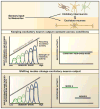Neocortical interneurons: from diversity, strength
- PMID: 20655460
- PMCID: PMC3655709
- DOI: 10.1016/j.cell.2010.07.005
Neocortical interneurons: from diversity, strength
Abstract
Interneurons in the neocortex of the brain are small, locally projecting inhibitory GABAergic cells with a broad array of anatomical and physiological properties. The diversity of interneurons is believed to be crucial for regulating myriad operations in the neocortex. Here, we describe current theories about how interneuron diversity may support distinct neocortical processes that underlie perception.
Copyright 2010 Elsevier Inc. All rights reserved.
Figures

References
MeSH terms
Grants and funding
LinkOut - more resources
Full Text Sources

